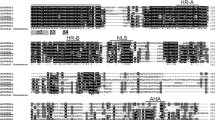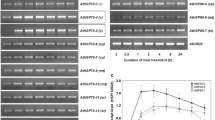Abstract
Heat stress transcription factors (HSFs) play an essential role in the adjustment of plants to high temperatures. These molecules have evolved complicated mechanisms that rely on interactions between different HSFs and other heat stress-related genes [such as bZIP28, multiprotein bridging factor 1c (MBF1c), calmodulin-binding protein kinase 3 (CBK3)] in response to different heat stresses (such as occasional or successive high temperatures). In the present study, phenotypic, gene expression and yeast two-hybrid assays revealed that HSFA2 and HSFA3 function in the same heat regulation pathway. The single mutants, hsfa2 and hsfa3 as well as double mutant hsfa2 and hsfa3, exhibited heat-sensitive phenotypes in acquired thermotolerance after a long recovery time (ATLR) but not in basic thermotolerance and acquired thermotolerance after a short recovery time (ATSR). The expression of HSP18.1-CI and HSP25.3-P was down-regulated in single and double mutants of hsfa2 and hsfa3 under successive heat stress in ATLR assays. In addition, HSFA2 interacted with HSFA3 at the protein level in yeast two-hybrid assays. These results demonstrated dynamic alterations in the expression of HSFA2, HSFA3 and other heat-related genes in ATLR assays, providing new insights into the relationship between HSFA2 and HSFA3; this information will refine the HSF network in the regulation of heat stress response.





Similar content being viewed by others
References
Baniwal SK, Chan KY, Scharf KD et al (2007) Role of heat stress transcription factor HsfA5 as specific repressor of HsfA4. J Biol Chem 282:3605–3613. doi:10.1074/jbc.M609545200
Charng YY, Liu HC, Liu NY et al (2007) A heat-inducible transcription factor, HsfA2, is required for extension of acquired thermotolerance in Arabidopsis. Plant Physiol 143:251–262. doi:10.1104/pp.106.091322
Chen H, Hwang JE, Lim CJ et al (2010) Arabidopsis DREB2C functions as a transcriptional activator of HsfA3 during the heat stress response. Biochem Biophys Res Commun 401:238–244. doi:10.1016/j.bbrc.2010.09.038
Evrard A, Kumar M, Lecourieux D et al (2013) Regulation of the heat stress response in Arabidopsis by MPK6-targeted phosphorylation of the heat stress factor HsfA2. Peer J 1:e59
Hahn A, Bublak D, Schleiff E et al (2011) Crosstalk between Hsp90 and Hsp70 chaperones and heat stress transcription factors in tomato. Plant Cell 23:741–755
Ikeda M, Mitsuda N, Ohme-Takagi M (2011) Arabidopsis HsfB1 and HsfB2b act as repressors of the expression of heat-inducible Hsfs but positively regulate the acquired thermotolerance. Plant Physiol 157:1243–1254
Laporte SA, Oakley RH, Zhang J et al (1999) The β2-adrenergic receptor/βarrestin complex recruits the clathrin adaptor AP-2 during endocytosis. Proc Natl Acad Sci USA 96:3712–3717
Larkindale J, Hall JD, Knight MR et al (2005) Heat stress phenotypes of Arabidopsis mutants implicate multiple signaling pathways in the acquisition of thermotolerance. Plant Physiol 138:882–897
Li M, Berendzen KW, Schoeffl F (2010) Promoter specificity and interactions between early and late Arabidopsis heat shock factors. Plant Mol Biol 73:559–567. doi:10.1007/s11103-010-9643-217
Li X, Yu E, Fan C et al (2012) Developmental, cytological and transcriptional analysis of autotetraploid Arabidopsis. Planta 236:579–596
Liu H, Charng Y (2012) Acquired thermotolerance independent of heat shock factor A1 (HsfA1), the master regulator of the heat stress response. Plant Signal Behav 7:547–550
Liu HC, Charng YY (2013) Common and distinct functions of Arabidopsis class A1 and A2 heat shock factors in diverse abiotic stress responses and development. Plant Physiol 163:276–290
Liu Q, Kasuga M, Sakuma Y et al (1998) Two transcription factors, DREB1 and DREB2, with an EREBP/AP2 DNA binding domain separate two cellular signal transduction pathways in drought-and low-temperature-responsive gene expression, respectively, in Arabidopsis. Plant Cell 10:1391–1406
Liu HC, Liao HT, Charng YY (2011) The role of class A1 heat shock factors (HSFA1s) in response to heat and other stresses in Arabidopsis. Plant Cell Environ 34:738–751. doi:10.1111/j.1365-3040.2011.02278.x
Lohmann C, Eggers-Schumacher G, Wunderlich M et al (2004) Two different heat shock transcription factors regulate immediate early expression of stress genes in Arabidopsis. Mol Genet Genom 271:11–21. doi:10.1007/s00438-003-0954-8
Luo M, Dennis ES, Berger F et al (2005) MINISEED3 (MINI3), a WRKY family gene, and HAIKU2 (IKU2), a leucine-rich repeat (LRR) KINASE gene, are regulators of seed size in Arabidopsis. Proc Natl Acad Sci USA 102:17531–17536. doi:10.1073/pnas.0508418102
Meiri D, Breiman A (2009) Arabidopsis ROF1 (FKBP62) modulates thermotolerance by interacting with HSP90.1 and affecting the accumulation of HsfA2-regulated sHSPs. Plant J 59:387–399. doi:10.1111/j.1365-313X.2009.03878.x
Meiri D, Tazat K, Cohen-Peer R et al (2010) Involvement of Arabidopsis ROF2 (FKBP65) in thermotolerance. Plant Mol Biol 72:191–203. doi:10.1007/s11103-009-9561-3
Nishizawa A, Yabuta Y, Yoshida E et al (2006) Arabidopsis heat shock transcription factor A2 as a key regulator in response to several types of environmental stress. Plant J 48:535–547. doi:10.1111/j.1365-313X.2006.02889.x
Nishizawa-Yokoi A, Nosaka R, Hayashi H et al (2011) HsfA1d and HsfA1e involved in the transcriptional regulation of HsfA2 function as key regulators for the Hsf signaling network in response to environmental stress. Plant Cell Physiol 52:933–945. doi:10.1093/pcp/pcr045
Nover L, Bharti K, Doering P et al (2001) Arabidopsis and the heat stress transcription factor world: how many heat stress transcription factors do we need? Cell Stress Chaperones 6:177–189. doi:10.1379/1466-1268(2001)006<0177:aathst>2.0.co;2
Sakuma Y, Maruyama K, Osakabe Y et al (2006a) Functional analysis of an Arabidopsis Transcription Factor, DREB2A, involved in drought-responsive gene expression. Plant Cell 18(5):1292–1309. doi:10.1105/tpc.105.035881
Sakuma Y, Maruyama K, Qin F et al (2006b) Dual function of an Arabidopsis transcription factor DREB2A in water-stress-responsive and heat-stress-responsive gene expression. Proc Natl Acad Sci USA 103:18822–18827. doi:10.1073/pnas.0605639103
Scharf KD, Berberich T, Ebersberger I et al (2011) The plant heat stress transcription factor (Hsf) family: structure, function and evolution. BBA Gene Regul Mech 1819:104–119
Schramm F, Ganguli A, Kiehlmann E et al (2006) The heat stress transcription factor HsfA2 serves as a regulatory amplifier of a subset of genes in the heat stress response in Arabidopsis. Plant Mol Biol 60:759–772. doi:10.1007/s11103-005-5750-x
Schramm F, Larkindale J, Kiehlmann E et al (2008) A cascade of transcription factor DREB2A and heat stress transcription factor HsfA3 regulates the heat stress response of Arabidopsis. Plant J 53:264–274. doi:10.1111/j.1365-313X.2007.03334.x
Vacca RA, De Pinto MC, Valenti D et al (2004) Production of reactive oxygen species, alteration of cytosolic ascorbate peroxidase, and impairment of mitochondrial metabolism are early events in heat shock-induced programmed cell death in tobacco Bright-Yellow 2 cells. Plant Physiol 134:1100–1112
Von Koskull-Doering P, Scharf KD, Nover L (2007) The diversity of plant heat stress transcription factors. Trends Plant Sci 12:452–457. doi:10.1016/j.tplants.2007.08.014
Yoshida T, Sakuma Y, Todaka D et al (2008) Functional analysis of an Arabidopsis heat-shock transcription factor HsfA3 in the transcriptional cascade downstream of the DREB2A stress-regulatory system. Biochem Biophys Res Commun 368:515–521. doi:10.1016/j.bbrc.2008.01.134
Yu E, Fan C, Yang Q et al (2014) Identification of heat responsive genes in Brassica napus siliques at the seed-filling stage through transcriptional profiling. PLoS One 9:e101914. doi:10.1371/journal.pone.0101914
Acknowledgements
This work was financially supported through a grant from the Special Foundation from Guizhou Academy of Agriculture Science ([2013] 003), the Provincial Natural Science Foundation of Guizhou Province (Qian J [2015]2080), and the Provincial Natural Science Foundation of Guizhou Province (Qian J LKN [2013] 04).
Author information
Authors and Affiliations
Corresponding authors
Additional information
Communicated by A Chandra.
X. Li and X. Wang contributed equally to the work.
Electronic supplementary material
Below is the link to the electronic supplementary material.
11738_2017_2351_MOESM1_ESM.tif
Fig. S1 Phenotypes of hsfa2, hsfa3 and hsfa2 hsfa3 in ATLR assays with different plant densities at different growth stages. (a-c) Seedlings planted using spaced sowing. (d-f) Seedlings planted using bunch sowing. (g) Schematic drawing showing the positions of all plant seedlings. (a, d) Plants grown under normal conditions. (b, e) Heat stress was performed at 3 d after sowing. (c, f) Heat stress was performed 7 d after sowing. The images were captured 13 d after sowing in control and ATSR and 17 d after sowing in ATLR (TIFF 4494 kb)
Rights and permissions
About this article
Cite this article
Li, Xd., Wang, Xl., Cai, YM. et al. Arabidopsis heat stress transcription factors A2 (HSFA2) and A3 (HSFA3) function in the same heat regulation pathway. Acta Physiol Plant 39, 67 (2017). https://doi.org/10.1007/s11738-017-2351-7
Received:
Revised:
Accepted:
Published:
DOI: https://doi.org/10.1007/s11738-017-2351-7




